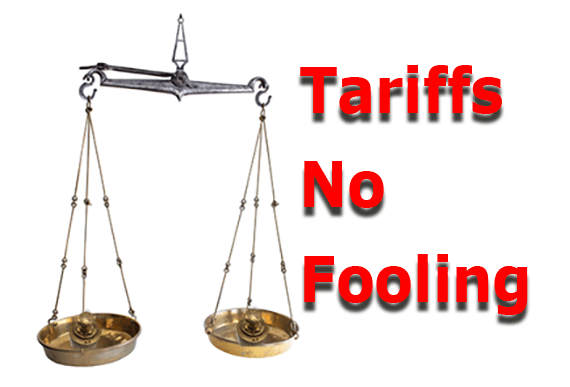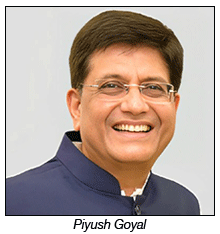 |
On April 2, U.S. President Donald Trump with "friendly" reciprocal tariffs celebrated “liberating day” in the White House Rose Garden stating, “we’re getting back some of the wealth that very, very foolish Presidents gave away because they had no clue what they were doing.”
Then President Trump announced a 10% tariff on imports. The U.S. will also levy an additional 50% of the tariff levied upon its goods by trading partners.
We can imagine that some smart traders might see the light of lowering their tariffs on U.S. goods, thus lowering tariffs levied against them at 50% under the Trump plan.
But for a moment let's look briefly at India.
Will these increased duties disrupt India’s export-oriented industries—such as pharmaceuticals, gems and jewelry, textiles, automobiles, and medical devices—and also lead to losses for Indian exporters? No doubt likely to be rising prices, In the automobiles sector, for example, higher tariffs on exports to the U.S.
Experts predict that a few companies like Mahindra and Mahindra Limited [Automotive and Farm Equipment Business] and Maruti Suzuki India Limited will be most affected by the tariffs.
Other than the automotive sector, the medical devices and the pharmaceutical sector will be affected. Cost of exporting to the U.S. will rise considerably and Indian manufacturers will have to seek other markets.
 The other sector that will feel the effect of tariffs will be textiles, which has been a major contributor to Indian exports. High tariffs set to be implemented by the U.S. surely will lead to a slowing down of demand from the U.S. and affect exports. The same will be the case with the gems and jewellery sector where the high duties will see a drastic cut in demand from U.S. buyers. However, exporters from India are hoping that ongoing trade negotiations and tariff adjustments will ease the situation. The other sector that will feel the effect of tariffs will be textiles, which has been a major contributor to Indian exports. High tariffs set to be implemented by the U.S. surely will lead to a slowing down of demand from the U.S. and affect exports. The same will be the case with the gems and jewellery sector where the high duties will see a drastic cut in demand from U.S. buyers. However, exporters from India are hoping that ongoing trade negotiations and tariff adjustments will ease the situation.
Quoting India's Pankaj Chadha, Chairman of the Engineering Exports Promotion Council:
"We are not going to sit back and take the punches. India will have to take reciprocal measures to deal with it.”
In 2023-24, India exported $18 billion worth of engineering goods to the U.S. In fact, India’s Commerce Minister Piyush Goyal was in the U.S. recently to negotiate with U.S. officials. Reportedly India has reduced tariffs on several U.S. exports, including high-end motorcycles and whisky and more reductions are expected upcoming.
 With U.S. tariffs threatening key exports, India is looking elsewhere to soften the blow. One approach on the table is a move to boost domestic manufacturing and secure new trade agreements. Other than exports from India, the Trump tariffs will impact the air cargo sector.| With U.S. tariffs threatening key exports, India is looking elsewhere to soften the blow. One approach on the table is a move to boost domestic manufacturing and secure new trade agreements. Other than exports from India, the Trump tariffs will impact the air cargo sector.|
Air cargo has long played a significant role in the efficient movement of goods. It is noteworthy that in 2022, India’s non-agricultural exports to the U.S. amounted to US$81.16 billion. Air cargo played a significant role in the efficient movement of goods. However, those were the good old days.
Today, with fresh tariffs and changes in regulations, new challenges have emerged. These challenges will hinder trade volumes and necessitate changes in logistical strategies.
A major hurdle that India’s air cargo industry faces is customs clearance. Some reforms have indeed taken place to increase efficiency—such as faceless assessment and single-window clearance. However, the focus on tariff classifications and duty structures has led to longer processing times for certain shipments. If these shipments include pharmaceuticals and perishables that must be cleared quickly, the entire process becomes critical. Experts have indicated that customs procedures need continued modernization to enhance India’s trade competitiveness.
To enable Indian airports to be more competitive and appealing as global hubs, like Dubai and Singapore, the Ministry of Civil Aviation is in discussions with the Home Ministry to implement specific measures. These include the elimination of rescreening. Relevant departments have started talks to remove the requirement for rescreening international passengers, their luggage, and transshipment cargo at airports where they transit.
Additionally, the government is considering conducting immigration procedures at the passenger's first or final destination, rather than at intermediary airports. While these moves will improve efficiency and reduce delays for both passengers and cargo, they will facilitate trade since the relaxation of cargo screening norms can promote global trade and reduce costs for businesses. Currently, passengers traveling from Bengaluru to San Francisco with a layover in Delhi must undergo immigration checks in Delhi, which could be streamlined with the proposed changes.
Additionally, experts have suggested adopting risk-based inspections to shorten clearance times. Moreover, the establishment of high-tech digital infrastructure at major air cargo hubs—including Delhi, Mumbai, and Bengaluru—will eliminate operational bottlenecks and enable seamless cargo movement.
It is important to note that with approximately 38 percent of India’s total non-agricultural airfreight exports destined for the U.S., the Indian government is keen to introduce policy initiatives to ensure continuity of trade. To start, air cargo infrastructure is being prioritized through enhancements in dedicated freighter capacity and multimodal connectivity between air and sea freight networks, even as preferential trade agreements (PTAs) and new duty structures come into effect.
Experts emphasize that India’s air cargo sector must be nimble and quick to adapt to regulatory developments. While the Indian government has announced its Mission 2030, which aims to expand air cargo handling capacity to 10 million metric tonnes, it requires a coordinated approach that includes regulatory synchronization, technological integration, and infrastructure enhancements to achieve sustainable progress in India’s air cargo ecosystem.
Now the cards are on the table and so is hope that new accords can be agreed upon.
Tirthankar Ghosh/GDA |




 Vol. 24 No. 14
Vol. 24 No. 14
 Vol. 24 No. 16
Vol. 24 No. 16